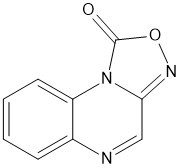ODQ | Soluble guanylyl cyclase inhibitor
NMR (Conforms)

Available Options
| Size: | Price | Quantity | |
|---|---|---|---|
| 5 mg | $30.00 | ||
| 25 mg | $84.00 |
ODQ (41443-28-1) is a potent and selective inhibitor of soluble guanylyl cyclase (sGC), IC50 = 20 nM).1 ODQ acts via competition with NO for the heme site of sGC where it binds irreversibly.2 ODQ does not inhibit NO-mediated macrophage toxicity, an activity that is unrelated to cGMP nor does it inhibit particulate GC.1 ODQ is an extremely useful tool to explore the involvement of the NO-cGMP pathway in cellular signaling and physiologic processes.3-5
References/Citations:
1) Garthwaite et al. (1995), Potent and Selective Inhibition of Nitric Oxide-sensitive Guanylyl Cyclase by 1H-[1,2,4]Oxadiazolo[4,3-a]quinoxalin-1-one; Mol. Pharmacol. 48 184
2) Schrammel et al. (1996), Characterization of 1H-[1,2,4]oxadiazolo[4,3-a]quinoxalin-1-one as a heme-site inhibitor of nitric oxide-sensitive guanylyl cyclase; Mol. Pharmacol. 50 1
3) Estevez et al. (1998), Nitric oxide-dependent production of cGMP supports the survival of rat embryonic motor neurons cultured with brain-derived neurotrophic factor; J. Neurosci. 18 3708
4) Vandecasteele et al. (1998), Role of the NO-cGMP in the muscarinic regulation of the L-type Ca2+ current in human atrial myocytes; J. Physiol. 506 653
5) Martins-Pinge et al. (1999), Nitric oxide-dependent guanylyl cyclase participates in the glutamatergic neurotransmission within the rostral ventrolateral medulla of awake rats; Hypertension 34 748
NMR (Conforms)
Safety Data Sheet:
Product Data Sheet:
Materials provided by Focus Biomolecules are for laboratory research use only and are not intended for human or veterinary applications. Please note that we do not sell to individuals and that all orders placed by non-research organizations will incur a $20 restocking/refund fee
ODQ (41443-28-1) is a potent and selective inhibitor of soluble guanylyl cyclase (sGC), IC50 = 20 nM).1 ODQ acts via competition with NO for the heme site of sGC where it binds irreversibly.2 ODQ does not inhibit NO-mediated macrophage toxicity, an activity that is unrelated to cGMP nor does it inhibit particulate GC.1 ODQ is an extremely useful tool to explore the involvement of the NO-cGMP pathway in cellular signaling and physiologic processes.3-5
References/Citations:
1) Garthwaite et al. (1995), Potent and Selective Inhibition of Nitric Oxide-sensitive Guanylyl Cyclase by 1H-[1,2,4]Oxadiazolo[4,3-a]quinoxalin-1-one; Mol. Pharmacol. 48 184
2) Schrammel et al. (1996), Characterization of 1H-[1,2,4]oxadiazolo[4,3-a]quinoxalin-1-one as a heme-site inhibitor of nitric oxide-sensitive guanylyl cyclase; Mol. Pharmacol. 50 1
3) Estevez et al. (1998), Nitric oxide-dependent production of cGMP supports the survival of rat embryonic motor neurons cultured with brain-derived neurotrophic factor; J. Neurosci. 18 3708
4) Vandecasteele et al. (1998), Role of the NO-cGMP in the muscarinic regulation of the L-type Ca2+ current in human atrial myocytes; J. Physiol. 506 653
5) Martins-Pinge et al. (1999), Nitric oxide-dependent guanylyl cyclase participates in the glutamatergic neurotransmission within the rostral ventrolateral medulla of awake rats; Hypertension 34 748
Calculate the molar concentration, mass or volume in a solution.
Concentration × Volume × Molecular Weight = Mass
Focus Biomolecules • Plymouth Meeting, PA USA • 1-855-FOCUS21
Focus Biomolecules
Plymouth Meeting, PA USA
1-855-FOCUS21
Website Created by Advanta Advertising LLC.

